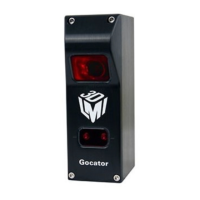Gocator Snapshot Sensors: User Manual
Gocator Web Interface • 83
5. Set the parameter values.
See the table above for more information.
The Y offset, X angle, and Z angle transformations cannot be non-zero when
Uniform Spacing is unchecked. Therefore, when aligning a sensor using a bar
alignment target with Uniform Spacing unchecked, set the Degrees of
Freedom setting to X, Z, Y Angle, which prevents these transformations from
being non-zero.
6. Save the job in the Toolbar by clicking the Save button .
7. Check that the transformation settings are applied correctly after the sensor is restarted.
Exposure
Exposure Mode Description
Single Uses a single exposure for all objects. Used when the surface is uniform and is the same for
all targets.
Multiple Uses multiple exposures to create a single scan. Used when the target surface has a varying
reflectance within a single scan (e.g., white and black).
Video mode lets you see how the light appears on the camera and identify any stray light or ambient
light problems. When exposure is tuned correctly, the projected light should be clearly visible along
the entire length of the viewer. If it is too dim, increase the exposure value; if it is too bright decrease
exposure value.
Under-exposure:
Light pattern is not fully detected.
Increase the exposure value.
Over-exposure:
Light pattern is saturated in the center.
Decrease the exposure value.
When the Gocator is in Multiple exposure mode, select which exposure to view using the second drop-
down box next to "View" in the data viewer. This drop-down is only visible in Video scan mode when the
Multiple option is selected in the Exposure section in the Sensor panel.
